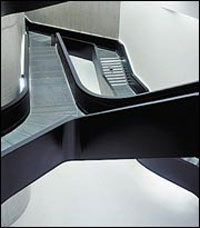 Rome’s newest art museum
Rome’s newest art museumBy Edwin Heathcote
Geological: interior of Rome's Maxxi
The plan for Rome’s new €150m Maxxi museum, designed by Zaha Hadid, looks like a diagram of a highly complex railway junction. It is hardly the most romantic image for a building billed as the city’s first major gallery of contemporary art, due to open in the spring. But as you enter the lobby, that fiercely reductive diagram disappears in a puff of theatrical dry-ice and reveals instead a thrillingly theatrical interior.
There is a persistent myth that Rome is a city free of modern architecture, that its rich history still weighs too heavily on its designers. The howls of derision aimed at American architect Richard Meier’s controversial 2006 Ara Pacis Museum revealed a seam of resentment and conservatism: one mayor even promised to demolish it. But despite such examples, from the powerful architecture of the fascist era to the city’s fine new galleries, modern Roman architecture is a unique blend of history and archetype.
The odd, rather bleak Flaminio district has become almost a museum of modernism, from the wonderful remains of Pier Luigi Nervi’s buildings for the 1960s Olympics to Renzo Piano’s highly successful 2002 Parco della Musica concert hall. Despite the quality of the architecture, though, Flaminio buzzes only on match or concert nights; at other times its curious emptiness is exacerbated by its fenced-off military compounds and barracks. The Maxxi aims to change that.
Its approach, across an old military site, is not promising. A hulking barracks fronts the street and shields the new building from view, but once you enter the generous gravel plaza, you are confronted by a museum that is, in its curious way, a museum-piece itself. It took so long to complete (a decade) that its design dates from an earlier phase in Hadid’s career: while her more recent buildings flow and undulate, the Maxxi retains the jagged, geological forms of a former period. Steel columns slant and clash, concrete volumes are cantilevered precariously over ribbons of circulation, the whole appears as a tangle of structural tagliatelle.
The jutting promontories and wrap-around bands of concrete are suspended seemingly in mid-air, forming a generous canopy, a dramatic covered piazza. But they don’t begin to prepare you for the interior. The glass doors slide open to reveal a breathtaking lobby space which is as theatrical as Borromini’s churches and as structurally inventive as anything by Nervi. The eye is drawn upward to that complex diagram plan extruded into three dimensions. Those railway tracks resolve themselves into fluid routes to create a sculptural world of black steel curves illuminated by neon-bright light boxes.
It recalls Hadid’s BMW factory in Leipzig, a building that celebrated the robotic ballet inherent in the production process, but here applies to the movement of the visitor through space. In Leipzig, the ultra-rational process guided the forms; in Rome it is pure drama, pure, wilful Baroque.
The first gallery at Maxxi is a restrained conversion of an existing barracks, good, solid found space. On the other side you are drawn up through the building on those dark ramps which create an undulating, fluid aerial landscape. The stairs are steel grids, glass floors give glimpses of floors below (and above); the routes lead to dramatic galleries that create convoluted landscapes of their own, culminating in views through and outside the building.
The question of how these galleries will accommodate art, however, remains unanswered. It is a further confirmation of how this new generation of super-museums is being perceived that the empty building was opened to the public for a weekend in November; David Chipperfield’s recent resurrection of the Neues Museum in Berlin had a similar “pre-opening”. There is an intriguing link here. Both Rome and Berlin are cities which have been haunted by ruins yet remain eager to confront modernity. The opening of the empty shell is a gesture to the idea of building as artefact, as a sculpture with a life of its own devoid of contents. It is hyper-modern yet, in its ambition, scale and complexity, it can’t help but refer to the visions of Piranesi – of a city of abandoned, empty behemoths, fragments from a past inhabited by mythical giants.
The Maxxi was initially conceived to house a collection of Arte Povera (for which you would have to consider the possibility that it may have been a spectacular failure) but is now billed as a “Museum for the Art of the XXI century” (from which its strange acronym derives). Yet although the Maxxi envelops one of the most thrilling and visionary interiors of recent years, it is about as far as it is possible to get from the neutral yet resonant found space which artists and curators like best. Can a brilliant piece of architecture containing questionable gallery space still be a brilliant piece of architecture? If what Rome wanted was a stunning structure which would convince the world this is a city capable of looking, Janus-like, simultaneously backwards and forwards, to both past and future, Hadid has done an impeccable job.
 Rome’s newest art museum
Rome’s newest art museum